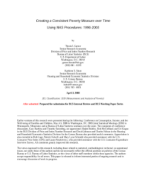Creating a Consistent Poverty Measure Over Time Using NAS Procedures: 1996-2005
Creating a Consistent Poverty Measure Over Time Using NAS Procedures: 1996-2005
Abstract
This paper presents an experimental poverty measure and compares it to the current official measure, now more than 40 years old. The experimental measure is based on an approach, drawn from work by a National Academy of Sciences (NAS) expert panel, to consistently define basic needs and family resources. The experimental thresholds are based on out-of-pocket spending by families on basic goods and services and are based on an “outflows” concept. The resource measure is based on an “inflows” concept and reflects money coming into the household that is available to meet one’s basic needs. The U.S. Consumer Expenditure Survey serves as the basis for the experimental thresholds and the Current Population Survey Annual Social and Economic Supplement serves as the basis for the resource measure. Results for 1996 to 2005 are reported with trends examined. An important finding is that increases in expenditures for shelter and utilities, captured in the new thresholds, suggest a greater increase in the number of families not able to meet basic needs than is reflected by the official poverty statistics.
Others in Series
Working Paper
Working Paper
Working Paper




